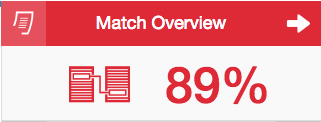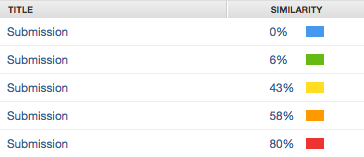

If you have never, ever used turnitin.com (TII), you will need to contact the JIS TII administrator, Matthew Schafer. If you have interacted with turnitin.com before, you have an account even if you have never logged in to their website. Go to www.turnitin.com and login in. Your username is your JIS email address. If you do not know your password, complete the "Forgot Your Password" process.

Once you are logged in and a member of the JIS Turnitin community you are good to go. Your home screen looks like this:

Note the tabs for your current and past classes. Also, note you can use TII as an instructor and as a student. Obviously we will be working as instructors.
Click the +Add Class button and fill out the Class Settings form as best you. The Enrollment Key is a simple password you can give to students so they can join your class. It can be anything you want so keep it simple: dragon, math-stinks, schafer-rocks, etc...

Hit Submit and your class is ready for an assignment. Do note when you can find the Class ID number and the edit button should you wish to make changes.

Enter your new class and click the +Add Assignment box. Give the assignment a clear name so students know they are uploading to the right assignment. You will need to set a start date, due date, and post date. (The post date is required and must be on or after the due date. All it is when TII can post the student's scores if you were using the Grade book feature.)
If this is your first time using the TII web interface you should go through the Optional Settings and set your preferences as defaults. These are my default settings. I highly recommend you start with these knowing you can change things as you become more familiar with the way TII works.

Skip the online grading settings for this lesson and be sure to check the "Would you like to save these options as your defaults..." box before "Submit."
Your assignment is now complete. Note you can edit and delete to the right.

From here, Step Four is getting a set of papers uploaded to turnitin.com, and there are multiple ways to accomplish this. All have advantages and disadvantages. You will need to find what works best for your workflow. Do note as of now, TII does not integrate with Google Classroom. If you collect papers in Google Classroom you or your students will need to take them to turnitin.com too.
Turnitin currently accepts the following file types for upload into an assignment that has the Allow only file types that Turnitin can check for similarity option enabled.
Microsoft Word® (DOC and DOCX)
Corel WordPerfect®
HTML
Adobe PostScript®
Plain text (TXT)
Rich Text Format (RTF)
Portable Document Format (PDF)
OpenOffice (ODT)
Hangul (HWP)
Powerpoint (PPT)
Google Docs via Google Drive™.
The file size may not exceed 100 MB and 800 pages or fewer. Files of a larger size may be reduced in size by the removal of non-text content. Files that are password protected, encrypted, hidden, system files, or read-only files cannot be uploaded or submitted to Turnitin.
Have students login to TII and enroll in your class. They must have your Class ID Number and the Enrollment Key password you created earlier.

Once inside your course, they open the assignment and upload their work just like they would add a picture to Instagram or Facebook. This does require a few more steps for students.

To upload a single file or files to turn it in, head to your assignment, click "More Actions," and "Submit."

If you have only one file to upload choose "Single File Upload." If you have multiples choose "Multiple...."

Select the paper(s) and complete the student name(s). Then click "Upload."

Review and double-check your information. If all is good click "Submit." This will take you to the assignment inbox where the papers wait until the originality reports are completed.

One can copy and paste text to upload to TII. You will, of course, lose the format, but the words will be checked as usual. This can be useful for checking online student writing such as a blog or online discussion post. Simply paste the text into the box.

Compressing multiple papers into a .zip file to upload to TII works well from Google Classroom. Start in the Classroom assignment. and find the folder icon to lead to the folder on Google Drive where the papers are stored.

Hold the COMMAND button on your MAC and select ALL the papers you wish to upload. In the pic below I have selected five files.

Then secondary click/right-click/select Download in the menu shown below. Google will zip the files in to one and sent it to wherever your downloads go (Downloads Folder? Desktop?).

Return to your turnitin.com com assignment, submit via "Zip File Upload", fill in names and titles as needed, and simply wait for your results.

The similarity score is a percentage of the paper's matches to other sources; it is not an assessment of whether the paper includes plagiarized material. The similarity report is a tool for instructors and students to easily find matches or similar text within submitted work.
The similarity score is a percentage of a paper's content that matches to Turnitin's databases; it is not an assessment of whether the paper includes plagiarized material. Turnitin does not check for plagiarism in a piece of work. Instead, we will check a student's work against our database, and if there are instances where a student's writing is similar to, or matches against, one of our sources, we will flag this for you to review. Our database includes billions of web pages: both current and archived content from the internet, a repository of works students have submitted to Turnitin in the past, and a collection of documents, which comprises thousands of periodicals, journals, and publications.

It is perfectly natural for an assignment to match against some of our database. If a student has used quotes and has referenced correctly, there will be instances where we will find a match. The similarity score simply highlights of any problem areas in a student's paper; you can then use this as an investigative tool, in order to determine if the match is or is not acceptable.
Similarity Reports provide a summary of matching or highly similar text found in a submitted paper. When a Similarity Report is available for viewing, a similarity score percentage will be made available. Similarity Reports that have not yet finished generating are represented by a grayed out icon in the Similarity column. Reports that are not available may not have generated yet, or assignment settings may be delaying the generation of the report.

Overwritten or resubmitted papers may not generate a new Similarity Report for a full 24 hours. This delay is automatic and allows resubmissions to correctly generate without matching to the previous draft.
The color of the report icon indicates the similarity score of the paper, based on the amount of matching or similar text that was uncovered. The percentage range is 0% to 100%. The possible similarity ranges are:
Blue: No matching text
Green: One word to 24% matching text
Yellow: 25-49% matching text
Orange: 50-74% matching text
Red: 75-100% matching text